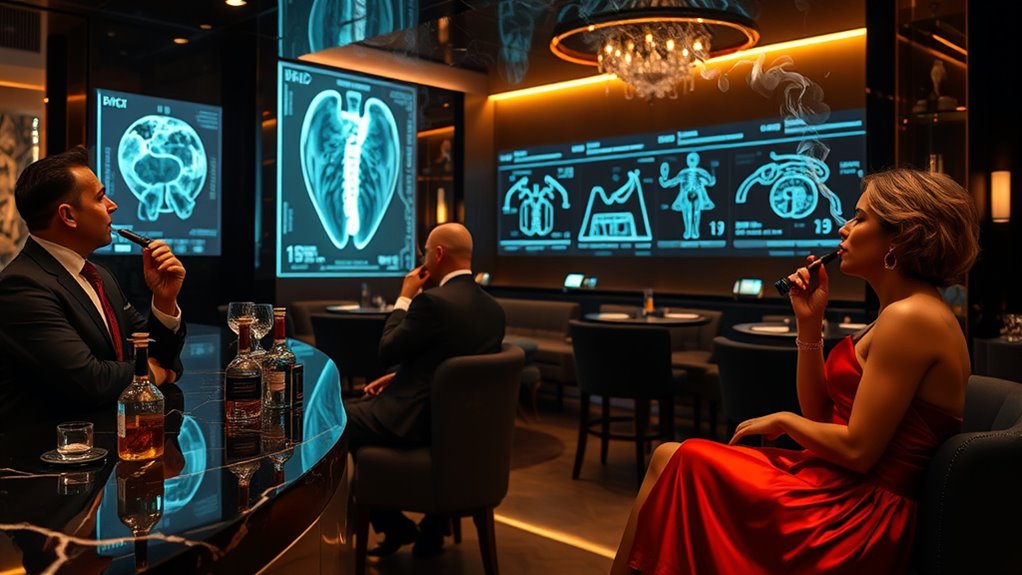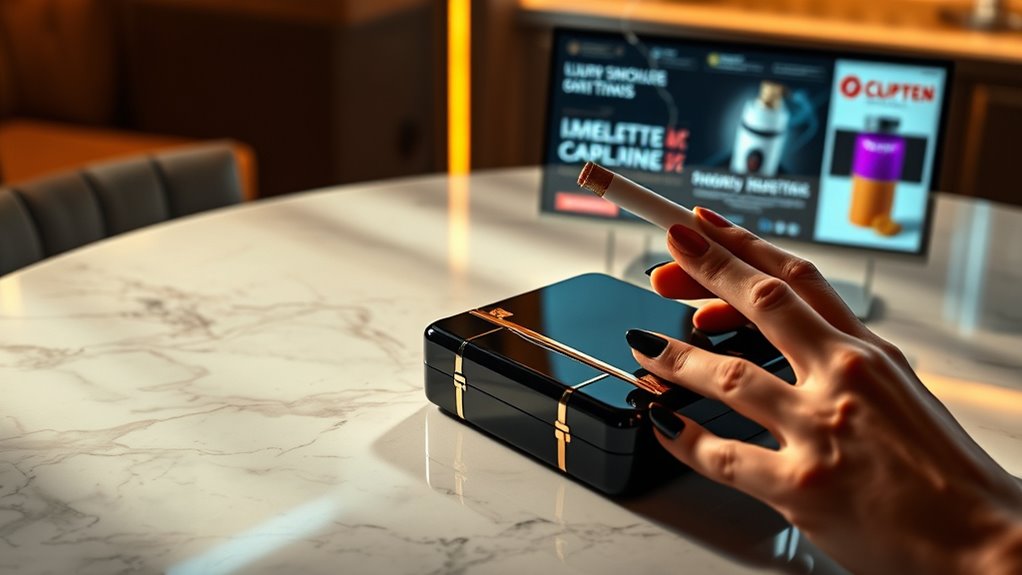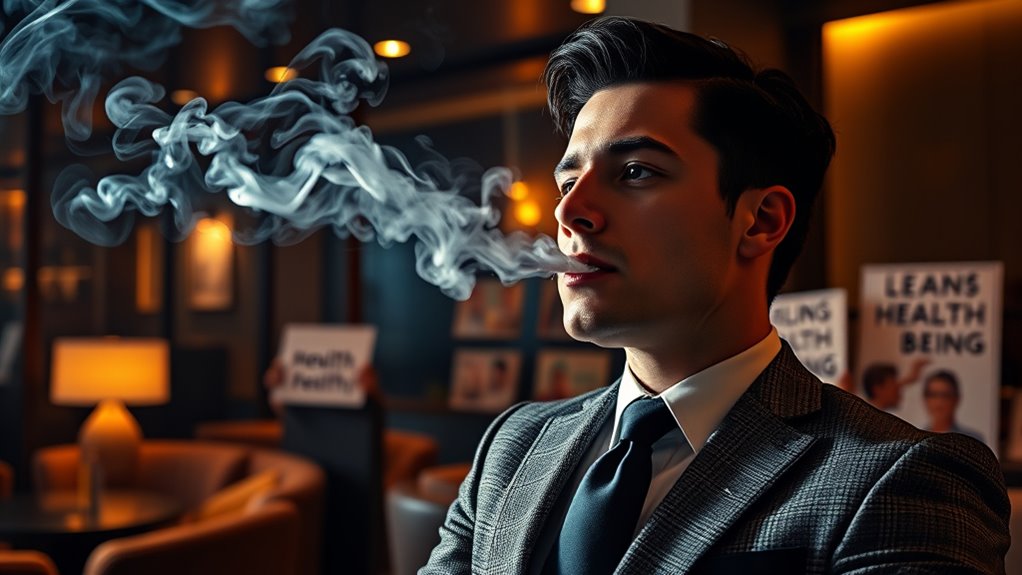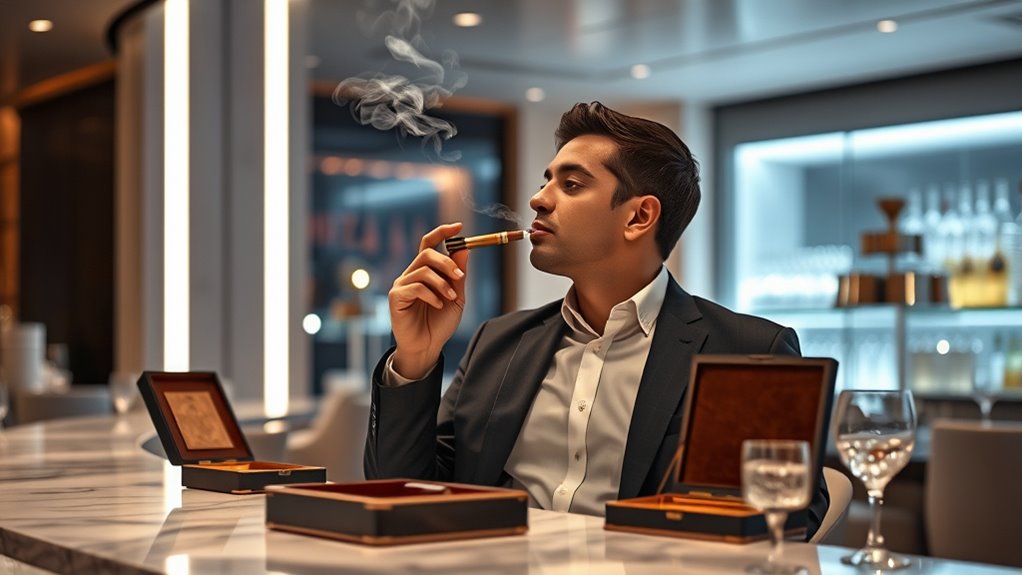In the modern world, smoking still romanticizes luxury and glamor, despite strong scientific evidence linking it to deadly diseases. Tobacco companies market heated tobacco products as trendy, less harmful options targeted at youth through sleek designs and social media campaigns. Industry tactics blur the lines between fashion and addiction, making smoking appealing again. Governments face challenges regulating these strategies, balancing personal freedom with public health. To discover how this ongoing debate shapes our society, keep exploring the evolving story behind tobacco’s glamorous facade.
Key Takeaways
- Historically glamorized, smoking’s image shifted due to scientific evidence linking it to serious health risks.
- Modern marketing of heated tobacco products targets youth with sleek designs and social media campaigns, despite health concerns.
- Industry tactics blur luxury, fashion, and addiction, normalizing smoking and creating gateway effects among young people.
- Regulatory challenges persist as authorities struggle to control new products, advertising strategies, and social media influence.
- Public health debates focus on balancing personal freedom with the need to reduce smoking rates and prevent youth initiation.
The Evolution of Smoking’s Social Image

Have you ever wondered how smoking went from being a symbol of glamour to a social taboo? In the early 20th century, smoking was seen as glamorous, representing success, beauty, and sophistication. Hollywood and advertisements promoted cigarettes as symbols of luxury and social status, even as scientific evidence of health risks was ignored. By the 1940s and 1950s, smoking’s cultural perception remained positive, reinforced by celebrity endorsements and media portrayals. However, after the 1964 U.S. Surgeon General’s report, public health concerns reshaped attitudes. Smoking shifted from a fashionable habit to a dangerous activity, with society increasingly viewing it as harmful and morally questionable. Additionally, the rise of public health campaigns awareness about environmental and health impacts further diminished its social acceptability. Today, public health campaigns continue to challenge its once-glamorous image, emphasizing its risks and social unacceptability.
Scientific Discoveries and Public Health Responses

The shifting social perception of smoking was driven in large part by groundbreaking scientific discoveries that exposed its true health risks. In 1964, the U.S. Surgeon General’s report linked smoking to lung cancer and bronchitis, based on extensive scientific evidence. This revelation shifted public health strategies worldwide, prompting measures like warning labels, advertising bans, and sin taxes. You should know that early studies showed nearly 90% of Dutch men smoked, but awareness of smoking risks led to declines. Tobacco companies attempted to undermine these findings by funding fake research and paying professionals to endorse smoking as healthy. These scientific evidence and public health responses transformed smoking from a fashionable habit into a major preventable health hazard. Your understanding of these developments highlights how scientific discoveries have shaped policies to protect public health, including public health strategies that aim to mitigate health-related financial risks later in life. Additionally, the recognition of smoking as a leading cause of preventable disease has influenced the development of smoking cessation programs, which are vital for reducing ongoing health burdens. Furthermore, advancements in scientific research continue to deepen our understanding of smoking-related health issues and inform future preventative measures.
The Rise of Heated Tobacco Products

Tobacco companies market heated tobacco products as a stylish, less harmful option, appealing especially to young people. Despite claims of reduced chemicals, these devices still release hundreds of toxins, some at dangerous levels. As you consider their popularity, it’s important to understand how marketing and chemical exposure impact health risks. For example, the presence of chemical exposure in these products can pose significant health concerns, even if the number of chemicals is lower than traditional cigarettes. Comprehensive coverage options in dog surgery insurance highlight the importance of evaluating potential risks and benefits before making health decisions.
Marketing Strategies and Youth Appeal
How are heated tobacco products like IQOS capturing the attention of young adults? Industry marketing uses sleek designs, social media influencers, and sponsorships at trendy events to make heated tobacco appealing. They portray these products as modern, stylish lifestyle choices, often partnering with celebrities and fashion brands to attract youth. Despite claims that they’re for adult smokers, branding appears at music festivals, fashion shows, and online platforms popular among teenagers. By emphasizing reduced harm and social acceptance, these campaigns downplay potential health risks and make heated tobacco seem like a safer, fashionable alternative to cigarettes. Data shows many IQOS users are under 30, highlighting the products’ appeal and potential as a gateway, raising concerns about tobacco’s impact on public health and youth initiation. Additionally, some studies suggest that the prophetic dreams associated with these marketing tactics influence perceptions and behaviors, especially among impressionable young audiences. The use of targeted advertising and affiliates further amplifies their reach, making these products more accessible to vulnerable populations. Moreover, industry strategies often leverage market segmentation to tailor messages that resonate with different youth demographics, increasing their effectiveness. Furthermore, the appeal of heated tobacco products is enhanced by their association with home furnishings and modern lifestyles, which are often promoted through stylish advertising campaigns.
Chemical Composition and Health Risks
Although heated tobacco products are often marketed as safer alternatives, they release thousands of chemicals during use, raising serious health concerns. The chemical composition of heated tobacco includes over 120 identified compounds, with some, like methylglyoxal, emitted in higher concentrations than in traditional cigarettes. During use, these devices reach temperatures around 330°C, similar to combustion, producing harmful pyrolysis byproducts. The aerosols contain high levels of fine particles that can penetrate deep into your lungs, carrying toxins linked to cardiovascular and respiratory health risks. While some research suggests heated tobacco has fewer harmful chemicals overall, the presence of toxic and carcinogenic substances still poses significant health risks. The FDA acknowledges these dangers, emphasizing that heated tobacco products are not safe for your health. Additionally, the chemical complexity of heated tobacco highlights the importance of understanding AI Safety measures to evaluate potential health impacts and regulate emerging tobacco technologies effectively. Moreover, the tobacco heating process can generate additional unpredictable chemical compounds, complicating safety assessments, which makes regulation and health risk evaluation more challenging. As advancements in mobile device AI processing continue, developing safer tobacco alternatives remains a critical area for public health oversight.
Marketing Strategies and Industry Tactics

To effectively market heated tobacco products, companies deploy sleek designs, celebrity endorsements, and multi-million dollar advertising campaigns that position these products as stylish lifestyle choices. The tobacco industry targets social media platforms like Instagram, TikTok, and YouTube, using influencers and sponsored content to appeal to young people. They sponsor events such as music festivals, boat parties, and Formula 1 races to boost brand visibility and associate their products with glamour and sophistication. Despite claims of responsible marketing, internal documents reveal efforts to subtly target youth and non-smokers through fashion collaborations and social media campaigns. These tactics help the industry maintain appeal among new generations, blurring the lines between luxury and addiction. Additionally, they often employ targeted advertising techniques to reach vulnerable demographics, increasing their influence and potential for addiction. Understanding how marketing strategies are employed allows for better awareness of the industry’s tactics to attract new consumers. Furthermore, some industry efforts include personality test themes in their branding to foster a sense of identity and exclusivity among consumers, subtly influencing preferences and loyalty.
Youth Engagement and Initiation Trends

You might think youth aren’t interested in heated tobacco, but marketing efforts are increasingly targeting them through social media and event sponsorships. While surveys show low usage now, studies suggest that even non-smokers exposed to these campaigns could be more likely to start smoking. Keep in mind, these tactics could be shaping a new generation of tobacco users before you realize it, especially as high-quality visuals make these products more appealing. Additionally, the strategic use of targeted advertising leverages social media’s reach to influence young audiences effectively.
Youth Usage Patterns
Are heated tobacco products truly attracting young users, or are their usage rates still too low to raise concern? In many countries, youth smoking of heated tobacco remains below 2%, with Japanese data showing less than 2% of students using these products. However, industry-funded studies indicate that non-smoking youth who try heated tobacco are up to 5.8 times more likely to start cigarette smoking within six months. Marketing strategies aimed at youth include sponsoring music festivals, partnering with streetwear brands, and social media influencer campaigns, which may boost appeal among adolescents. Despite claims of limited exposure, youth are still exposed to heated tobacco advertising through platforms like TikTok and Instagram, often without strict age checks. These patterns raise questions about heated tobacco’s role as a gateway for youth. Additionally, the global entertainment industry heavily influences youth culture, potentially shaping perceptions of smoking and vaping behaviors. The advertising and promotion methods employed by the tobacco industry often exploit youth-oriented trends and media channels to normalize usage, especially by leveraging media influence to shape social norms. Moreover, public health research suggests that even minimal exposure can have significant impacts on youth perceptions and behaviors related to tobacco use.
Marketing Targeting Youth
Marketing strategies targeting youth have become a central focus for heated tobacco companies, utilizing social media influencers, trendy events, and fashionable collaborations to capture younger audiences. These campaigns often feature youthful imagery, sponsorships at music festivals, and fashion partnerships designed to appeal to minors and non-smoking adolescents. Studies reveal that heated tobacco and e-cigarette marketing effectively attract youth, with surveys showing up to 1.4% of high school students trying these products. Industry tactics create a gateway effect, as non-smokers who initiate heated tobacco are more likely to start smoking cigarettes later. Despite claims of minimal youth targeting, public health experts warn that marketing, product placement, and sponsorships are deliberately crafted to appeal to younger demographics.
| Tactics | Platforms/Events | Target Audience |
|---|---|---|
| Social media | Influencers | Youth, Teens |
| Trendy events | Music festivals | Adolescents |
| Fashion collabs | Brand collaborations | Young Adults |
| Sponsorships | Concerts, sports | Minors |
| Visual marketing | Youth-oriented imagery | Non-smokers |
Regulatory Challenges and Policy Debates

Regulatory challenges surrounding heated tobacco products have become increasingly complex as governments try to keep pace with innovative marketing strategies and new delivery devices. You face the difficult task of balancing public health concerns with the influence of the tobacco industry. Policymakers grapple with questions like whether to tighten bans, enforce age restrictions, or develop new regulations for emerging nicotine devices. The tobacco industry’s sophisticated tactics—such as social media campaigns and event sponsorships—make regulation even harder, especially when public health is at stake.
You should consider:
- How existing policies can adapt to new marketing tactics
- The role of regulatory bodies like the FDA in authorizing products without proven safety
- The ongoing debate over stricter bans versus harm reduction approaches
Navigating Personal Freedom and Collective Well-Being

Balancing individual rights with public health concerns remains at the heart of the smoking debate. You want the freedom to make personal choices, but tobacco regulations aim to protect non-smokers from secondhand smoke and reduce health risks. Despite legal restrictions, about 20-30% of certain populations still smoke, showing the tension between personal freedom and societal well-being. Marketing heated tobacco products to youth and non-smokers raises worries about influencing new generations and undermining public health efforts. Public opinion varies; some see smoking as a personal right, while others recognize the societal costs of smoking-related diseases. Ultimately, policy decisions must navigate this delicate balance, ensuring personal liberty doesn’t come at the expense of collective health.
Frequently Asked Questions
What Does the World Health Organization Say About Smoking?
The WHO clearly states that no form of smoking is safe for your health. They highlight that cigarette smoke contains thousands of chemicals, many toxic and carcinogenic. They urge you to recognize the dangers, including the risk of severe health issues and death. The organization recommends strong policies like warnings, taxes, and bans to help you and others reduce tobacco use and protect public health worldwide.
Can Lungs Heal After 20 Years of Smoking?
You might think it’s a tall order, but lungs can heal even after 20 years of smoking. When you quit, your cilia start to regenerate, and your lung capacity can improve over time. While some damage, like emphysema, may be permanent, stopping now prevents further harm. Your breathing and quality of life can get a lot better, proving it’s never too late to give your lungs a fighting chance.
Was Smoking Considered Classy?
You probably think about smoking as something that used to be associated with class and sophistication. Back in the early 20th century, it was seen as glamorous, often linked to celebrities and luxury lifestyles. Hollywood stars made smoking look stylish, and campaigns targeted women to see it as elegant. Over time, society shifted, and smoking lost its classy image, becoming more about vice than refinement.
Does Smoking Burn Belly Fat?
You might wonder if smoking burns belly fat, but the truth is, it doesn’t. Nicotine may temporarily suppress your appetite and boost your metabolism slightly, but these effects are minimal and won’t lead to significant fat loss. Plus, smoking actually promotes inflammation and insulin resistance, which can make belly fat worse. Instead, focus on eating healthy and exercising; those are your best options for losing belly fat.
Conclusion
As you navigate the smoky haze of modern smoking, remember it’s a delicate dance between personal freedom and public health. Like a tightrope walker balancing grace and danger, society must weigh individual choice against collective well-being. The evolving landscape demands vigilance, innovation, and thoughtful regulation. Ultimately, your choices shape the future of this smoky saga—whether it becomes a fleeting shadow or a lasting legacy in the story of health and liberty.










